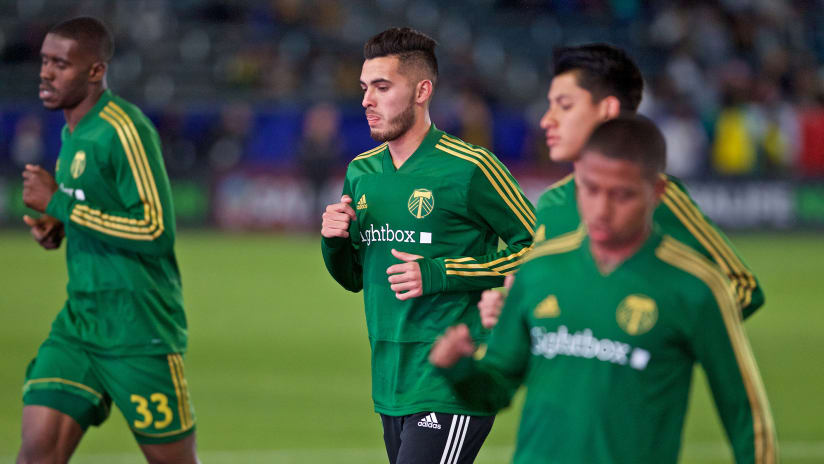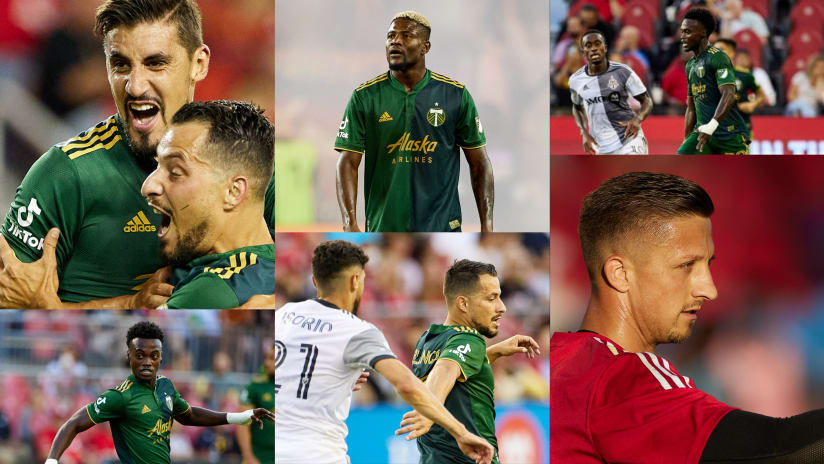BEAVERTON, Ore. -- The acquisitions would look ambitious for most USL teams, let alone a USL team that finished with three wins in 32 games last season.
But Honduran international
Darixon Vuelto and Costa Rican Marvin Loria aren’t being brought in to fit the 2017 version of T2. The pair of 20-year-old attackers, whose signings were announcedlast week, are part of a larger plan, one that extends from the top of Portland’s first-team depth chart to the players who are just now emerging from the team’s Academy. T2’s new talents may be on loan from their Central American clubs, but in Vuelto and Loria, we’re seeing Portland's now - a broader approach to depth and youth.
“If we’re going to continue to be a club that’s successful, we have to continue to look to bring good, young players into the club while they are affordable and before they become unobtainable financially for an MLS salary cap,” Timbers general manager Gavin Wilkinson explains. “For us to remain competitive both short-term and long-term, they have to be good enough right now, but we also have to see them as being players who can grow with this club and contribute to the first team.”
That vision is why defender Marco Farfan continues to be integrated to the first team straight from the Timbers’ Academy, the same route that’s produced Stanford grad Foster Langsdorf, who joins the team this season. That focus also made striker Jeremy Ebobisse a priority in the 2017 MLS SuperDraft and acquiring winger Eryk Williamson's valuable Homegrown rights earlier this winter. It’s also why, of the various routes Wilkinson could have taken with the team’s Targeted Allocation Money, acquiring 19-year-old Paraguayan midfielder Cristhian Paredes was prioritized.
It’s all part of the evolution of a club that’s seven years into its MLS journey; one whose roster not only expects to compete at the top of the Western Conference in the present, but needs to build a system to maintain that level. That means developing layers of talent throughout the organization that can be ready for bigger roles as veterans phase out, even if that means accepting a broader vision of what youth development entails.
“When you start looking at things through the lens of the first team, the second team, and also the Academy, you have to look for what make sense at every single layer,” Wilkinson says. “That means succession planning at every position.
“We track the players in the club via one massive roster where we have every single player in the club listed, and we try to address areas of potential need.”
The primary option will always be the Academy, a route that has started to be more productive with the development of players like Farfan and Langsdorf. That production has been evident throughout the winter’s sessions with T2, with multiple Academy players training with the USL side throughout the preseason.
“We have to give the Academy time to develop,” Wilkinson said, “and those Academy players need to be given playing time with T2.”
In Major League Soccer, though, one route is not going to be enough; at least, you concede a competitive advantage if you ignore other ways to acquire talent. That’s why, where there’s been an opportunity and a need, Wilkinson has acquired other Homegrown players.
He was the first general manager in MLS to trade for a Homegrown Player’s rights when he acquired Bryan Gallego from the New York Red Bulls in 2012. This season, Wilkinson made a slightly bigger splash, trading for University of Maryland midfielder Eryk Williamson’s rights from D.C. United.
Now, with the league giving teams the option of spending $2.8 million dollars of discretionary Targeting Allocation Money (in addition to teams’ $1.2 million of “mandatory” TAM), the international market has become a viable option for long-term planning. Add in the annual MLS SuperDraft, and you have a number of different channels clubs can pursue to layer their talent.
“When you start to look at areas of your roster, you ask, ‘Are we getting quality relative to the investment and what is the profile, age we're missing in an area?,’” Wilkinson explained. All of Williamson, Paredes,
Andy Polo and Julio Cascante are not only quality players, but they also fit the bill in terms lines of succession planning for their positions within the club.
“Obviously, the individual player needs to be quality,” Wilkinson continued. “You have to explore all options, the college draft, your own academy, other teams academies, also young domestic or foreign options for T2. Additionally, you need to bring quality players into the first team. The quality additions to the first team can be through trading with another MLS team, for example another clubs Homegrown Player like Eryk Williamson, or going outside of the league looking for young internationals, such as Cristhian Paredes.”
You do all of this with the future in mind, but it can’t come at the expense of the present. Coming off a first-place finish in the Western Conference’s regular season, Portland remains focused on the now.
“It’s about finding balance,” Wilkinson said. “It’s about finding players who are good enough to help the team be successful, both short-term and long-term. We use just about every mechanism possible, so that’s trading international spots, GAM, TAM, to get the rights to players, and we also look at trading up in the draft, as you’ve seen [last year] with Jeremy Ebobisse.”
Those moves have helped the Timbers forge a deep squad, one head coach Giovanni Savarese sees as having two quality options at every position on the field. With that depth addressed, Wilkinson can pursue the next level, T2, targeting players who will not only help the USL club but, shortly, can be the next options at Savarese’s level.
“The focus has to be on the first team,” is Wilkinson’s reminder, “but it’s developing a quality club roster where, together, all Timbers teams can flourish. That’s ultimately what we want.
“We brought in a young Costa Rican international. We brought in a young Honduran international. Part of that is to help them acclimate to see how they develop in our environment, to see if they are going to be able to help the club in the long-term.”
Having the ability to target acquisitions for T2, players you can develop from within, should have benefits beyond the 2017 season – benefits which, in a salary-cap league like MLS, could transcend the players’ value on the field.
“For us, spending a little bit now, potentially saving in the future, makes sense as an organization,” Wilkinson said. “We also look at the Academy players who could be moved up from the Academy to T2. It’s important to have positional competition and competitive balance, and that’s what we’re trying to manage.”
Darixon Vuelto and Marvin Loria may mark a new level of ambition for T2 signing, but it’s part of a bigger plan. It’s a plan that involves the Academy. It’s a plan the involves the draft. It’s a plan that involves every intricacy of Major League Soccer’s complicated rules.
Now, with the senior squad deeper than ever, the Timbers’ approach to youth is about making sure their layers of talent can fill in when today’s stars fade out. It’s about balancing out that larger, team-wide depth chart.












